
An ancient counterfeiter's coin mold. (29 mm diameter)

An ancient counterfeiter's coin mold. (29 mm diameter)
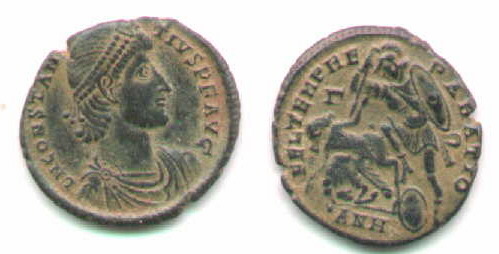
A genuine coin of the same type. (24mm diameter)
Ancient Roman coins were struck, but counterfeiters occasionally used genuine coins to make molds from which counterfeits were cast. This page illustrates such molds for common "FEL TEMP REPARATIO" coins of the reform of Constantius II and Constans c. AD 348 - 350. The molds are for full-size counterfeits, not for the very common reduced size counterfeits which were usually struck coins.
A group of molds was found in an unknown location. Eleven molds of the same diameter (29mm) were used in a "gang mold" to cast ten counterfeit coins at once (each of diameter about 23mm). Nine of the molds are two-sided, and two of the molds are endpieces and have but one side.

This is a side view of the molds stacked together (probably not in the original order), with the pouring channel slots lined up. It seems they were to fit together in a stack, but the precise order in which they fit has not been determined, and it seems there may have been still more molds in the original group that did not come with these. To make the casting process work, there may have been three stacks side-by-side so the moulten metal could be poured down the gap between them (cf. George Boon, "Counterfeit coins in Roman Britain", Figure 4B). If so, this group is missing many of the original molds.
Here is a side view of the fit of the four that might have originally fit together
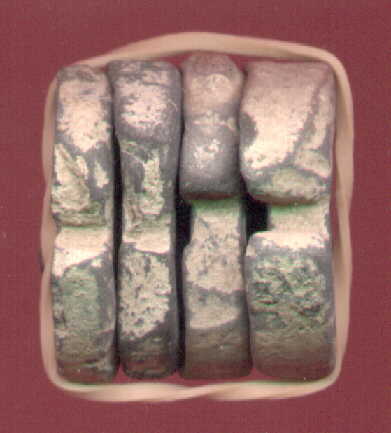

and the opposite view of the same four. The others certainly did not fit together, except possibly molds 8 and 10 (one of the two endpieces).
Articles about original finds of molds suggest most (on average, nine in ten) are found broken. We think that these may be eleven unbroken ones selected from a larger find to give the impression of a single stack. There are two endpieces, one piece with two heads, and one with two tails. That could make a single stack. But, our research suggests that they were not used in a single stack, but in at least two (and probably three) stacks side by side so that the metal had a channel to flow through. So, this cannot be a complete find.
Here are images of the eleven molds for ten coins. All have reverses have the common "FEL TEMP REPARATIO" legend. Eight are of the "soldier spearing fallen horseman" type and two are of the "galley" types. Eight of the obverses are of emperor Constantius II (AD 337-361) with legend "DN CONSTANTIVS PF AVG". The remaining two obverses are of emperor Constans (AD 337 - 35) with legend "DN CONSTANS PF AVG". Although it might be expected that the galley reverses would match the Constans obverses, the physical characteristics of the molds make it impossible that two Constans/galley coins could have been used to make the corresponding molds.
The molds, except for the endpieces, generally have a pronounced convex side and a concave side. Presumably this is the result of each piece of clay being pushed into the next one as the genuine coins were used to make the molds. The molds are listed here (in no particular order) with the convex side first (all eleven in one scan and the other sides in the next scan).
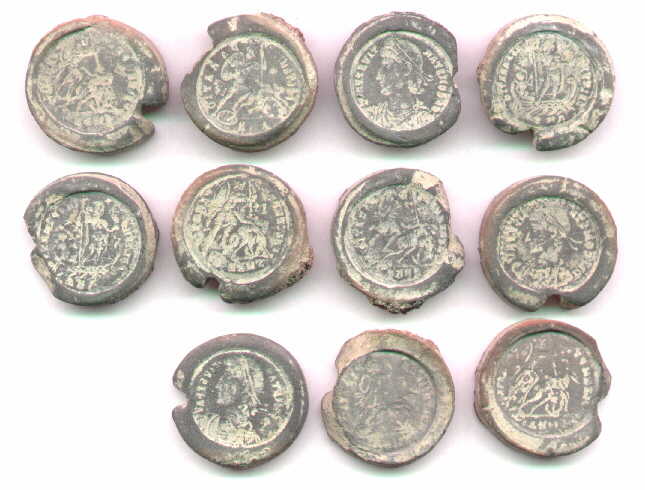
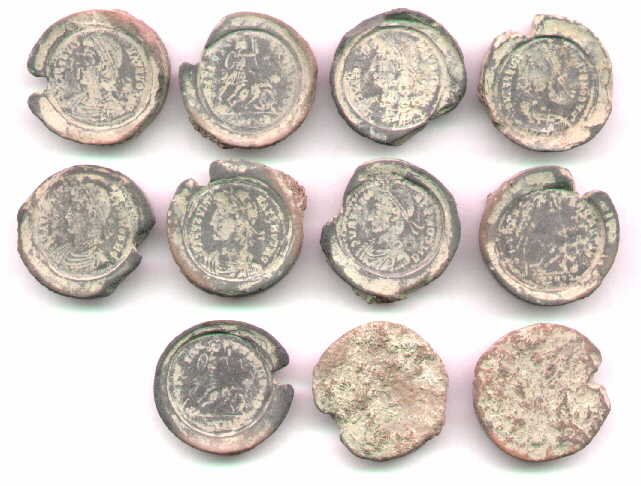
Mold: Constans / fallen horseman, SM??
Mold: fallen horseman, weak mintmark / Constantius II
Mold: fallen horseman, * in field, ANA(?) / fallen horseman, SMN? (two reverses)
Mold: Constantius II / Constantius II (two obverses)
Mold: fallen horseman, SMK? / Constantius II
Mold: fallen horseman, ?MK? / Constans
Mold: galley (phoenix), AN? / Constantius II
Mold: galley (clear phoenix) ANA or ANdelta / Constantius II
Mold: Constantius II / fallen horseman, ?M??
Mold: end / fallen horseman, SMKdelta
Mold: end / fallen horseman, weak, maybe SMKdelta
These molds were studied by Warren Esty and Rick Pope.
Our thanks go to Kevin Barry of Barry and Darling Ancient Coins and Christian Ziehe, Compressore Ancient coins and artifacts, who very kindly let us borrow these for study.
Modern experiment: This was in an attempt to discover how the molds worked. The idea comes from ancient molds described and illustrated by George Boon in his article on them and from the ancient molds above.
To do: Find suitable clay. Press genuine coins into disks of it to make molds. Stack the discs into a column. Cut away part of the edge to allow metal to flow into the gap. Stack three such columns together with their gaps together in the middle. Make a clay funnel to hold the unmelted metal and put it on top. Put the whole thing in a kiln (We used an art professor's ceramics kiln). Heat the kiln with wood or charcoal like we imagine the ancients did.
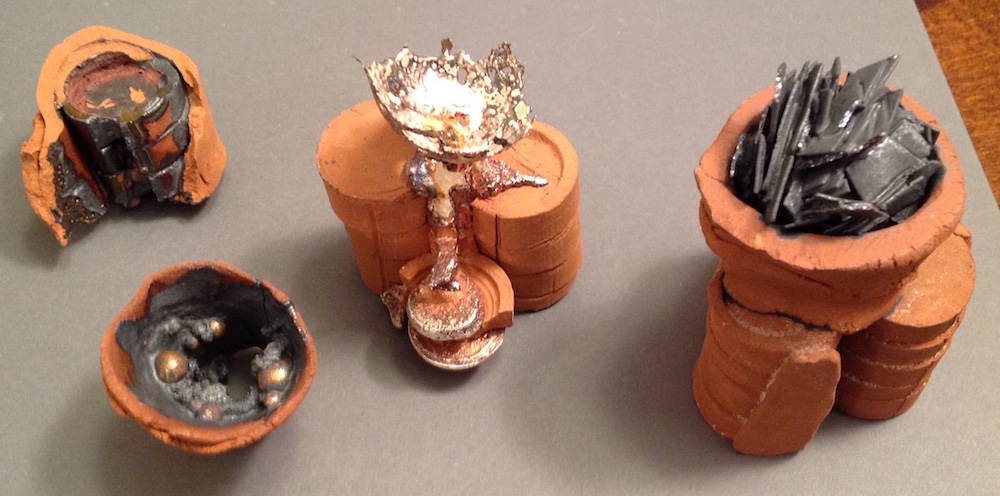
Every try failed miserably. We (an art professor and I) tried far more times than are illustrated here. We then gave up (however, keep reading). We think we did not get the metal hot enough to really flow. I think a wood fire or a charcoal fire is not hot enough unless you have some way of getting it much hotter than normal.
Parts: Upper left, a column of three molds, wrapped in clay and with the cut down the side to allow molten metal to enter.
On the right, a stack of three columns of molds, after firing that was obviously not hot enough.
In the middle, a stack, formerly of three columns, with one broken away to see if the molds had been filled and the clay of the funnel broken away. As you can see, the bottom one filled partially and the second one only fractionally and the top mold not at all. It still was not hot enough.
At the bottom left, the funnel from a different melt. You can see not all the metal flowed down into the stack.
The same mold parts from the side:
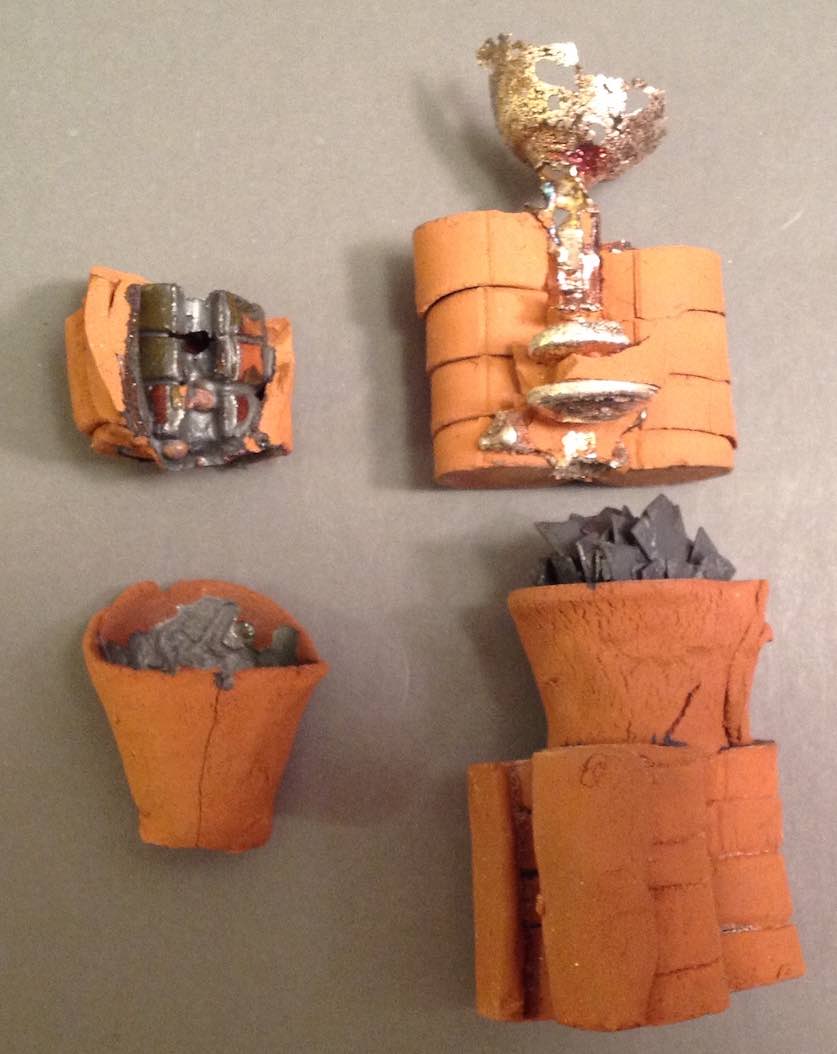
There are people (for instance, in the Society for Creative Anachronism) who make "coins" with ancient techniques. They know more than I do about how it was done. This is only my record of what we tried. By the way, when we cheated and used a blowtorch we did get passable results.
Return to the main site on ancient imitations.